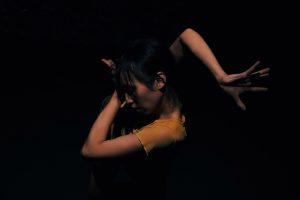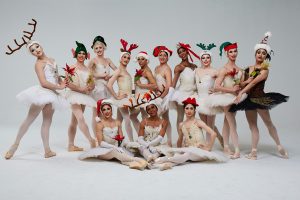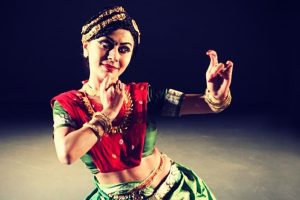
© Siva Prasad Thekkilematam. (Click image for larger version)
Neena Prasad / Dancing the Gods Festival
Cholkettu and Ganesha Sthuti, Sankara Sri Giri, Anandavalli, Amrapali
★★★✰✰
New York, Symphony Space
22 April 2017
www.neenaprasad.com
www.symphonyspace.org
www.worldmusicinstitute.org
Enchanting Dances
Despite its common origins in the ancient Sanskrit text the Natya Shastra, Indian classical dance comes in an infinite variety of styles and forms. The schools most often performed abroad seem to be bharatanatyam, from Tamil Nadu in the south, and kathak, from northern India, followed perhaps by odissi, from the west. New York is particularly lucky to receive regular visits by the extraordinary odissi troupe Nrityagram, based near Bangalore. Last year, as part of the White Light Festival, there was also an unforgettable performance by a kathakali theatre group from Kerala, in full regalia of hooped skirts, face-makeup, and headwear. As an aside, another artist who used to come fairly frequently was the quick and light-footed kuchipudi dancer Shantala Shivalingappa, but she hasn’t had a solo evening in the area since her 2013 appearance at the Festival of Arts and Ideas in New Haven. It’s time someone brought her back.
This year’s Dancing the Gods festival, presented by the World Music Institute and co-curated by the dancer and historian Rajika Puri, opened with a solo evening of mohiniyattam, a comparative rarity. The featured performer, Neena Prasad, is well known both in dancing and academic circles in India; she is both a practitioner and a scholar of the form. Like kathakali, mohiniyattam comes from south-eastern coastal state of Kerala. It’s not as old as the other Indian dances, dating back only to the middle of the nineteenth century. Its creation, in fact, came as the result of the barring of women from kathakali, in which men depict both male, female, and godly roles. Mohiniyattam, which is performed only by women, has many similarities to bharatanatyam, but the dance also shares some characteristics with kathakali – a few of the hand gestures and facial expressions, in particular a slightly un-focussed, eyes-crossed look that comes across the dancer’s face at times, almost as if she were looking inward or meditating.

© Prasssanna Kumar E M. (Click image for larger version)
Mohiniyattam is known as the “dance of the enchantress” – it is extremely feminine and flowing, and devoid of the rhythmic attack and angularity that makes some of the other dances so exciting. The rhythms of the feet are much simpler, for example, than in bharatanatyam or kuchipudi, the expressions less varied, and the range of movements more circumspect. Instead, the dancer sways and tilts, communicating meaning through her delicate hand movements and glistening eyes. The effect is less dazzling, more subtle perhaps, but also, to the untrained eye, less varied and even at times repetitive, though always pleasing and swayingly musical.
Neena Prasad was all charm; her eyes laughed and glowed as she danced. Her presence onstage was relaxed, precise but without the crispness or accent of other forms. She seemed to respond most sensitively to the singer’s voice, rather than to the rhythms beaten out by the drummer. She reflected on the words, savoured them, showing them in the expressions of her face and the mudras – ritualized gestures – she made with her hands. More than at other Indian-dance recitals, I regretted not understanding the words of the songs. The musicians, in turn, were in constant conversation with each other, led by the singer, C. Madhavan Nampoothiri.

© Siva Prasad Thekkilematam. (Click image for larger version)
Because of the unspectacular nature of the dances, Prasad came most alive in the illustrative segments of the evening. In Sankara Sri Giri, her evocation of Shiva’s anger upon being disturbed by his wife Parvati during meditation, was terrifying. With two fingers on her forehead, she illustrated the opening of his third eye, and its disastrous effects: fire, melting snow, avalanches, floods. One could see them all. The final dance of the evening, the pièce de résistence, was a veritable epic. To music composed by Mr. Nampoothiri, she danced the tale of Amrapali, a courtesan who falls in love with the crown prince of an enemy state. She became both Amrapali, seductive and dreamy, and her lover, a handsome braggart sure of his conquest. Her fingers, tracing a flower from her heart to the body of her beloved, illustrated the bonds of love as clearly as if she had been weaving silver threads. Her face drew close to that of the invisible lover, with eyes half-closed, bliss filling her body with a kind of inner light. Then she switched gears, becoming the angry herd of town-folk, condemning her for her illicit love. Finally, after torment and prayer, Prasad’s Amrapali found enlightenment, walking slowly, with a kind of otherworldly serenity, toward the Buddha, as the three musicians chanted the same words, over and over.
So, despite being less thrilling than some other Indian dance performances we’ve seen in New York in recent seasons, this evening of moniniyattam certainly had its charms.

















As always, Marina Harss is articulate and explanatory, and I particularly relished her comments on the Kathakali tradition and Mohiniattam as its offspring for women.
One of the first female roles to learn in Kathakali is the dance of Mohini.Some of us who studied with Shivaram in the late ‘Fifties and early “Sixties were introduced to its technical demands. Mohiniattam, I think, stems from this dance, and I have in mind one of my fellow students, quite a robust woman, and how she relished each phrase and gesture.
May I point out that Odissi comes from the state once called Oriya and is the site
of the famous temple at Konorak. All on the East, not West coast of India, roughly the middle of the sub-continent.
Thank you! Fascinating!